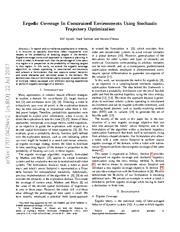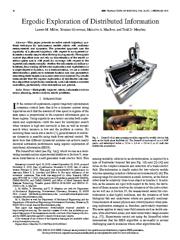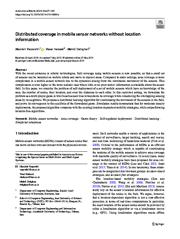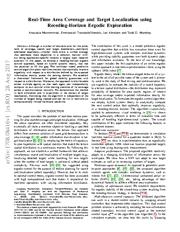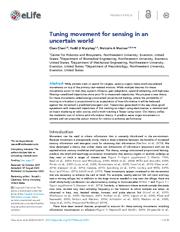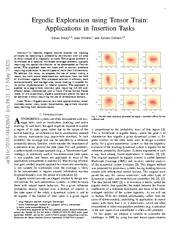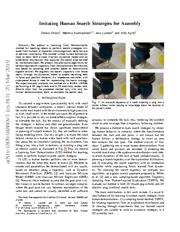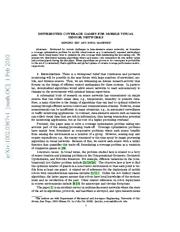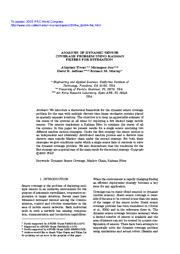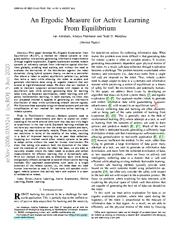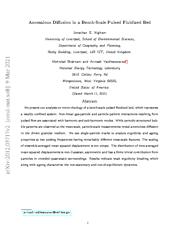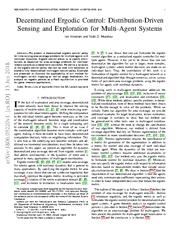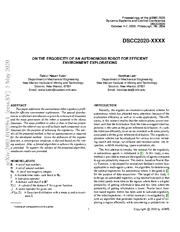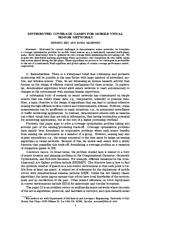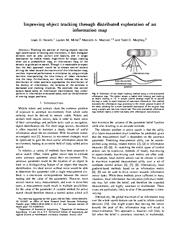A copy of this work was available on the public web and has been preserved in the Wayback Machine. The capture dates from 2020; you can also visit the original URL.
The file type is application/pdf.
Filters
Ergodic Coverage In Constrained Environments Using Stochastic Trajectory Optimization
[article]
2017
arXiv
pre-print
In this work, we extend the ergodic coverage algorithm to robots operating in constrained environments and present a formulation that can capture sensor footprint and avoid obstacles and restricted areas ...
We demonstrate that our formulation easily extends to coordination of multiple robots equipped with different sensing capabilities to perform ergodic coverage of a domain. ...
Our formulation also allows a robot with a wide sensor footprint to perform coarse ergodic coverage of the domain, while a robot with narrow sensor footprint performs dense ergodic coverage of the same ...
arXiv:1707.04294v2
fatcat:2jglyduqnbg4pe2vbrcarvc2ty
Ergodic Exploration of Distributed Information
2016
IEEE Transactions on robotics
This paper presents an active search trajectory synthesis technique for autonomous mobile robots with nonlinear measurements and dynamics. ...
The presented approach uses the ergodicity of a planned trajectory with respect to an expected information density map to close the loop during search. ...
In addition, as the sensors are rigid with respect to the body, the movement of those sensors involves the dynamics of the entire robot. ...
doi:10.1109/tro.2015.2500441
fatcat:5iekfur745hhlbrymdaa6hxjma
Distributed coverage in mobile sensor networks without location information
2019
Autonomous Robots
Compared to static settings, area coverage is more complicated in a mobile sensor network due to the dynamics arising from the continuous movement of the sensors. ...
With the recent advances in robotic technologies, field coverage using mobile sensors is now possible, so that a small set of sensors can be mounted on mobile robots and move to desired areas. ...
Once the strong ergodicity of {P ε(t) t } is established, we can leverage on the main result of Zhu and Martínez (2013) to associate the stochastically stable states of the chain {P ε(t) t } with the ...
doi:10.1007/s10514-019-09859-y
fatcat:6eo5ydtibzfsnn4245maved7zy
Real-Time Area Coverage and Target Localization using Receding-Horizon Ergodic Exploration
[article]
2017
arXiv
pre-print
The nonlinear model predictive control algorithm plans real-time motions that optimally improve ergodicity with respect to a distribution defined by the expected information density across the sensing ...
We establish a theoretical framework for global stability guarantees with respect to a distribution. ...
[76] propose a stochastic differential dynamic programming algorithm for ergodic exploration in the presence of stochastic sensor dynamics. ...
arXiv:1708.08416v1
fatcat:qwhkc5qq6zh67dbkubqeaghdra
Tuning movement for sensing in an uncertain world
2020
eLife
Our theory unifies the metabolic cost of motion with information theory. It predicts sense organ movements in animals and can prescribe sensor motion for robots to enhance performance. ...
Trajectories generated in this way show good agreement with measured trajectories of fish tracking an object using electrosense, a mammal and an insect localizing an odor source, and a moth tracking a ...
Appendix 1 Background on ergodicity Ergodicity plays an important role in multiple scientific disciplines particularly in stochastic systems and statistical mechanics. ...
doi:10.7554/elife.52371
pmid:32959777
pmcid:PMC7508562
fatcat:a32weip7z5fevfsbyzftct6go4
Ergodic Exploration using Tensor Train: Applications in Insertion Tasks
[article]
2021
arXiv
pre-print
In this experiment, ergodic exploration allows the task to be achieved without requiring the use of force/torque sensors. ...
The approach is applied to a peg-in-hole insertion task requiring full 6D end-effector poses, implemented with a 7-axis Franka Emika Panda robot. ...
., stochasticity in the contact dynamics involved in the insertion). ...
arXiv:2101.04428v2
fatcat:qhfdasjsmzbs5i3bogau34amd4
Imitating Human Search Strategies for Assembly
[article]
2019
arXiv
pre-print
We present two alternative algorithms for computing a search trajectory from the exploration distribution, one based on sampling and another based on deterministic ergodic control. ...
We augment the search trajectory with forces learnt through the dynamics model to enable searching both in force and position domains. ...
Creating the Search Trajectory We propose two methods for generating a search trajectory that covers the modeled exploration distribution: 1) TSHIX, a stochastic sampling-based method, and 2) ergodic control ...
arXiv:1809.04860v3
fatcat:whiq3uxy6bfybknidbthe5itsa
Distributed coverage games for mobile visual sensor networks
[article]
2010
arXiv
pre-print
Motivated by current challenges in data-intensive sensor networks, we formulate a coverage optimization problem for mobile visual sensors as a (constrained) repeated multi-player game. ...
Each visual sensor tries to optimize its own coverage while minimizing the processing cost. ...
The dynamically changing exploration rate renders the algorithm an inhomogeneous Markov chain (instead of the homogeneous ones in [19] [20] ). ...
arXiv:1002.0367v1
fatcat:qpdinsn6onbkrhczkz7zhnwcjy
ANALYSIS OF DYNAMIC SENSOR COVERAGE PROBLEM USING KALMAN FILTERS FOR ESTIMATION
2005
IFAC Proceedings Volumes
We introduce a theoretical framework for the dynamic sensor coverage problem for the case with multiple discrete time linear stochastic systems placed at spacially separate locations. ...
For both these strategies we give conditions under which a single sensor fails or succeeds to solve the dynamic coverage problem. ...
INTRODUCTION Sensor coverage is the problem of deploying multiple sensors in an unknown environment for the purpose of automatic surveillance, cooperative exploration or target detection. ...
doi:10.3182/20050703-6-cz-1902.00361
fatcat:xzm3h4n5qjbvri5ybjodhd4mci
An Ergodic Measure for Active Learning From Equilibrium
[article]
2020
arXiv
pre-print
against the robot dynamics. ...
This paper develops KL-Ergodic Exploration from Equilibrium (KL-E^3), a method for robotic systems to integrate stability into actively generating informative measurements through ergodic exploration. ...
Stochastic Transition Model Learning In this next example KL-E 3 is used to collect data for learning a stochastic transition model of a quadcopter [40] dynamical system by exploring the state-space ...
arXiv:2006.03552v1
fatcat:s5k72jrgendpnnuyymjv5tpbtu
Anomalous Diffusion in a Bench-Scale Pulsed Fluidized Bed
[article]
2021
arXiv
pre-print
Results indicate weak ergodicity breaking which along with ageing characterize the non-stationary and out-of-equilibrium dynamics. ...
Non-linear gas-particle and particle-particle interactions resulting from pulsed flow are associated with harmonic and sub-harmonic modes. ...
To elucidate non-ergodic dynamics in PFB, we define ergodicity-breaking parameter (EB) as, EB(∆) = δ 2 (∆) 2 δ 2 (∆) 2 − 1 (7) EB represents dispersion in δ 2 , and we examine its variation with T to identify ...
arXiv:2012.05717v2
fatcat:a3mwrg5qardabj4xic3p4mun2u
Decentralized Ergodic Control: Distribution-Driven Sensing and Exploration for Multiagent Systems
2018
IEEE Robotics and Automation Letters
We present a decentralized ergodic control policy for time-varying area coverage problems for multiple agents with nonlinear dynamics. ...
We derive a variation to the ergodic control policy that can be used with consensus to enable a fully decentralized multi-agent control policy. ...
Bearing only sensors [7] , [34] are used for sensing the target with the same three agents as mentioned in Section V with quadcopter dynamics. ...
doi:10.1109/lra.2018.2849588
dblp:journals/ral/AbrahamM18
fatcat:od2v3uolqnatzgbbgwzv2rozfm
On the Ergodicity of an Autonomous Robot for Efficient Environment Explorations
[article]
2020
arXiv
pre-print
This paper addresses the autonomous robot ergodicity problem for efficient environment exploration. ...
Given the definition of the ergodic function, a convergence condition is derived based on the timing analysis. Also, a formal algorithm to achieve the ergodicity is provided. ...
In [8] , a trajectory optimization approach is developed for robotic ergodic exploration where stochastic nonlinear sensor dynamics has been considered. ...
arXiv:2005.01959v1
fatcat:kod23lje7bf73iv6qatalnikzm
Distributed Coverage Games for Energy-Aware Mobile Sensor Networks
2013
SIAM Journal of Control and Optimization
Motivated by current challenges in data-intensive sensor networks, we formulate a coverage optimization problem for mobile visual sensors as a (constrained) repeated multi-player game. ...
Each visual sensor tries to optimize its own coverage while minimizing the processing cost. ...
The dynamically changing exploration rate renders the algorithm an inhomogeneous Markov chain (instead of the homogeneous ones in [17] [18] ). ...
doi:10.1137/100784163
fatcat:nnat4jblcva2zgzqpwagi3qgvm
Improving object tracking through distributed exploration of an information map
2014
2014 IEEE/RSJ International Conference on Intelligent Robots and Systems
The sensor dynamics consist of a simple second order linear system with an inertial term, a damping term, and no stiffness with full actuation in 1D given by md + bḋ = f, (6) where m and b are the mass ...
For example, the sensor will explore areas of lower EID if areas of higher EID had been explored recently. An overview of this method is shown in Algorithm 1.
II. METHODS
A. ...
doi:10.1109/iros.2014.6943042
dblp:conf/iros/NevelnMMM14
fatcat:fhbcumcntvbnvlnsmesticqv4y
« Previous
Showing results 1 — 15 out of 1,986 results

